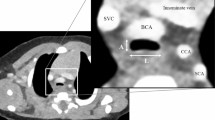Abstract
Bronchoscopy-guided aortopexy is a surgical management option for patients with central airway obstruction after congenital heart surgery. This study aimed to evaluate the usefulness of bronchoscopy-guided aortopexy based on midterm follow-up evaluation with computed tomography (CT) and clinical outcome. From January 2004 to August 2011, bronchoscopy-guided aortopexy was performed for 16 patients (median age 0.5 years, M:F = 10:6) who had central airway obstruction caused by extrinsic compression (13 in the left main bronchus, 2 in the trachea, 1 in the diffuse trachea and bronchus) after congenital heart surgery. The surgical site for aortopexy was determined by the anatomic relationship between the aorta and the compressed bronchus according to preoperative CT and intraoperative bronchoscopy. The median follow-up period was 2.3 years. The ratios of the diameter and area of stenosis at the narrowed point were estimated using pre- and postoperative CT. Almost all the patients (15/16) showed relief of their preoperative symptoms. The median extubation time was 18 h. The stenosis diameter and area ratios significantly improved, as shown by with the immediate postoperative CT (7.7–48.5 %, p = 0.003; 54.8–80.5 %, p = 0.006). Airway stenosis of more than 75 % (p = 0.013), immediate diameter ratio improvement of <50 % (p = 0.015), preoperative severe respiratory insufficiency (p = 0.038), and male sex (p = 0.024) were associated with recurrent minor respiratory susceptibility. Bronchoscopy-guided aortopexy is a safe and reliable surgical management choice for central airway obstruction after congenital heart surgery. Furthermore, airway improvement after aortopexy was maintained during the midterm follow-up evaluation, according to CT measurements.




Similar content being viewed by others
References
Abdel-Rahman U, Ahrens P, Fieguth HG, Kitz R, Heller K, Moritz A (2002) Surgical treatment of tracheomalacia by bronchoscopic monitored aortopexy in infants and children. Ann Thorac Surg 74:315–319
Abdel-Rahman U, Simon A, Ahrens P, Heller K, Moritz A, Fieguth HG (2007) Aortopexy in infants and children—long-term follow-up in twenty patients. World J Surg 31:2255–2259
Anand R, Dooley K, Williams W, Vincent R (1994) Follow-up of surgical correction of vascular anomalies causing tracheobronchial compression. Pediatr Cardiol 15:58–61
Beigelman-Aubry C, Brillet PY, Grenier PA (2009) MDCT of the airways: technique and normal results. Radiol Clin North Am 47:185–201
Corno A, Giamberti A, Giannico S, Marino B, Rossi E, Marcelletti C et al (1990) Airway obstructions associated with congenital heart disease in infancy. J Thorac Cardiovasc Surg 99:1091–1098
Donnelly L, Bisset G, McDermott B (1995) Anomalous midline location of the descending aorta: a cause of compression of the carina and left mainstem bronchus in infants. Am J Roentgenol 164:705–707
Gidding S, Beekman R, Lebowitz E, Wesley J, Coran A, Behrendt D et al (1984) Airway compression by a right aortic arch in the absence of a vascular ring. Chest 85:703–705
Greenholz SK, Karrer FM, Lilly JR (1986) Contemporary surgery of tracheomalacia. J Pediatr Surg 21:511–514
Grillo HC (1994) Slide tracheoplasty for long-segment congenital tracheal stenosis. Ann Thorac Surg 58:619–621
Griscom N, Wohl M, Kirkpatrick J Jr (1978) Lower respiratory infections: how infants differ from adults. Radiol Clin North Am 16:367–387
Manning PB, Rutter MJ, Lisec A, Gupta R, Marino BS (2011) One slide fits all: the versatility of slide tracheoplasty with cardiopulmonary bypass support for airway reconstruction in children. J Thorac Cardiovasc Surg 141:155–161
Marmon LM, Bye MR, Haas JM, Balsara RK, Dunn JM (1984) Vascular rings and slings: long-term follow-up of pulmonary function. J Pediatr Surg 19:683–692
McElhinney DB, Reddy VM, Pian MS, Moore P, Hanley FL (1999) Compression of the central airways by a dilated aorta in infants and children with congenital heart disease. Ann Thorac Surg 67:1130
Ming Z, Lin Z (2007) Evaluation of tracheal bronchus in Chinese children using multidetector CT. Pediatr Radiol 37:1230–1234
Rapp-Bernhardt U, Welte T, Doehring W, Kropf S, Bernhardt TM (2000) Diagnostic potential of virtual bronchoscopy: advantages in comparison with axial CT slices, MPR and mIP? Eur Radiol 10:981–988
Robotin M, Bruniaux J, Serraf A, Uva M, Roussin R, Lacour-Gayet F et al (1996) Unusual forms of tracheobronchial compression in infants with CHD. J Thorac Cardiovasc Surg 112:415–423
Valerie EP, Durrant AC, Forte V, Wales P, Chait P, Kim PCW (2005) A decade of using intraluminal tracheal/bronchial stents in the management of tracheomalacia and/or bronchomalacia: is it better than aortopexy? J Pediatr Surg 40:904–907
Vazquez-Jimenez JF, Sachweh JS, Seipelt R, Seghaye MC, Messmer BJ (2001) Aortopexy reduces anastomosis stress after repair of coarctation. Ann Thorac Surg 72:294–295
Wright CD, Graham BB, Grillo HC, Wain JC, Mathisen DJ (2002) Pediatric tracheal surgery. Ann Thorac Surg 74:308–314
Author information
Authors and Affiliations
Corresponding author
Rights and permissions
About this article
Cite this article
Jang, W.S., Kim, WH., Choi, K. et al. Aortopexy With Preoperative Computed Tomography and Intraoperative Bronchoscopy for Patients With Central Airway Obstruction After Surgery for Congenital Heart Disease: Postoperative Computed Tomography Results and Clinical Outcomes. Pediatr Cardiol 35, 914–921 (2014). https://doi.org/10.1007/s00246-014-0875-9
Received:
Accepted:
Published:
Issue Date:
DOI: https://doi.org/10.1007/s00246-014-0875-9




